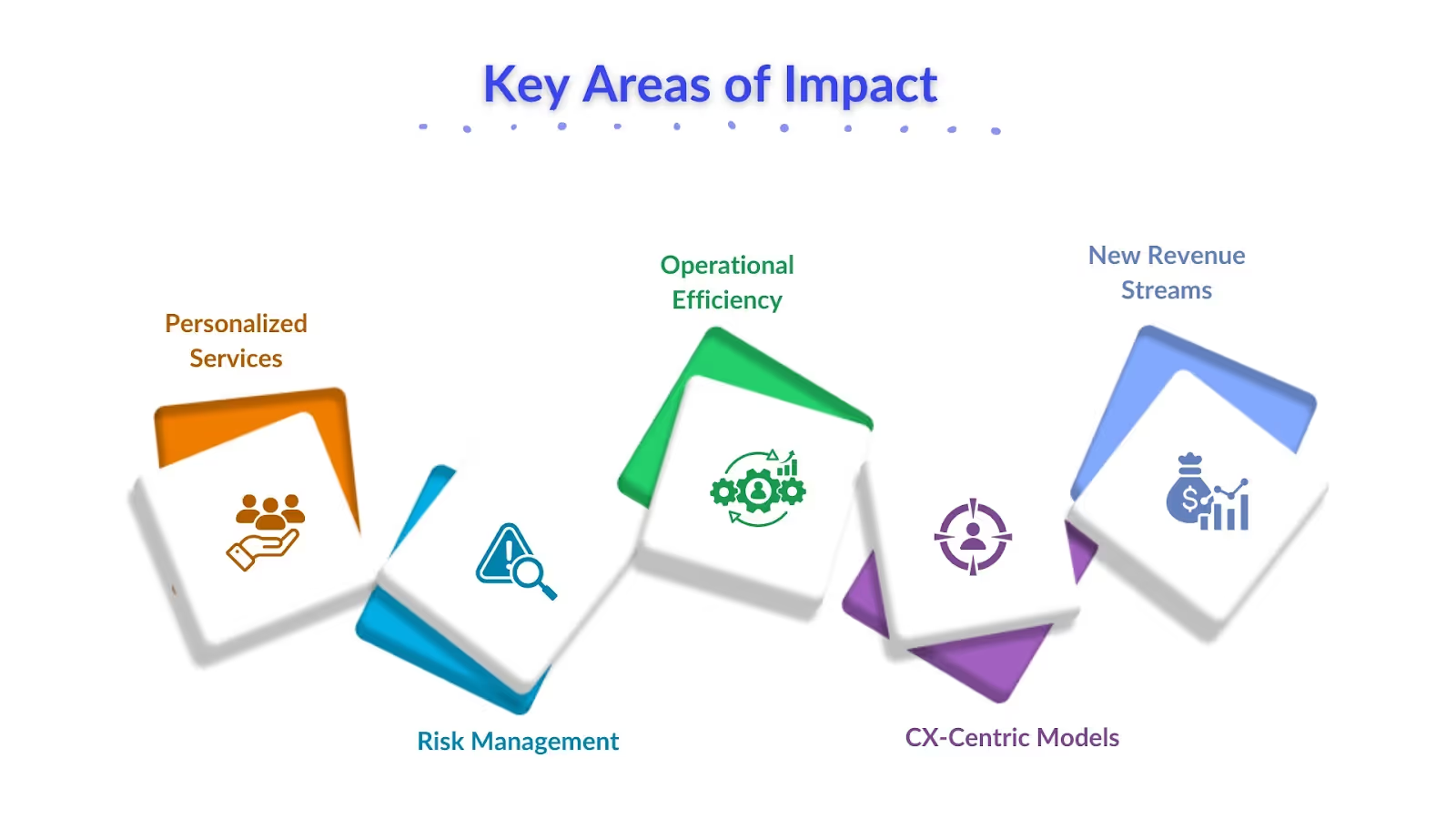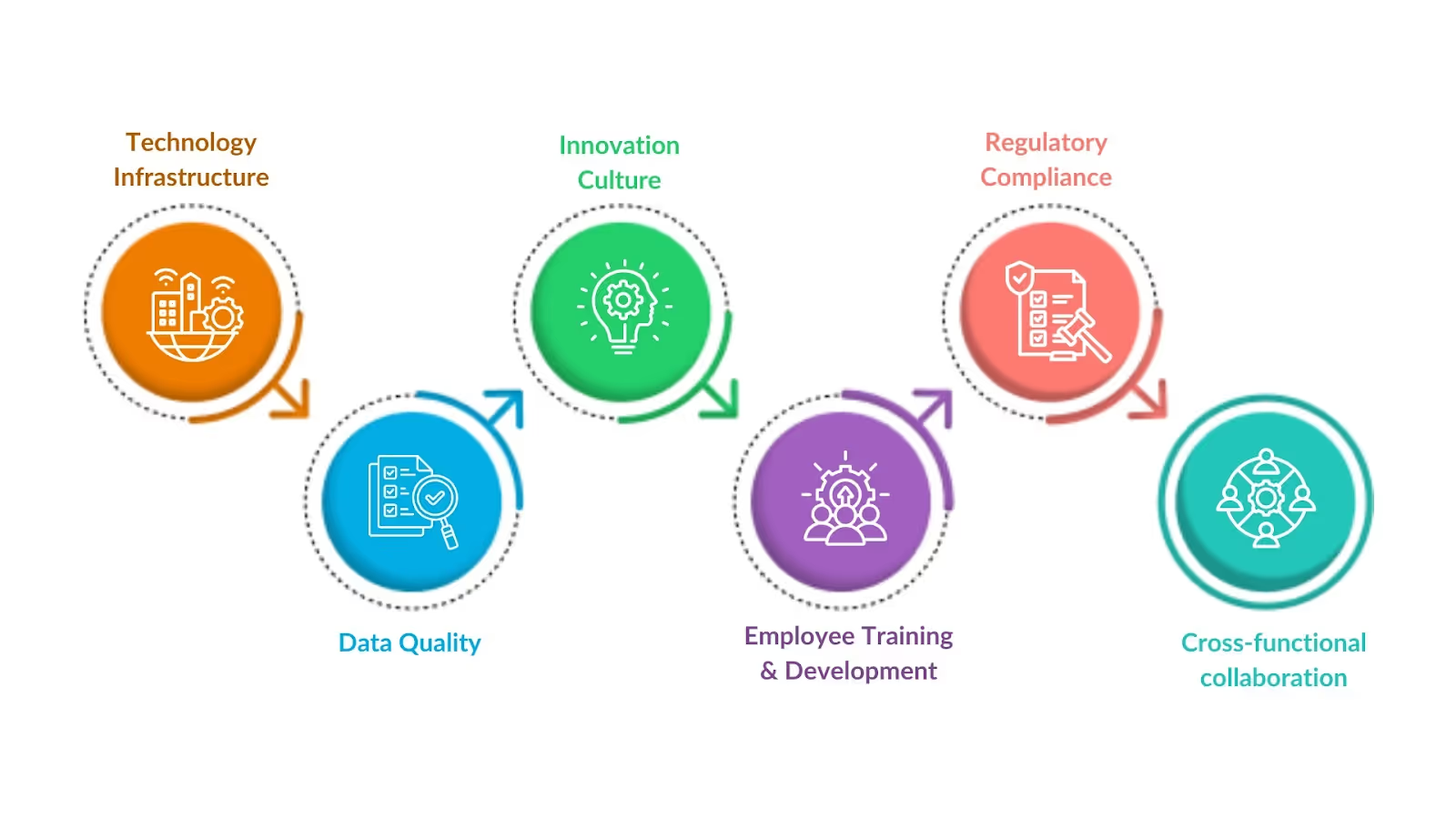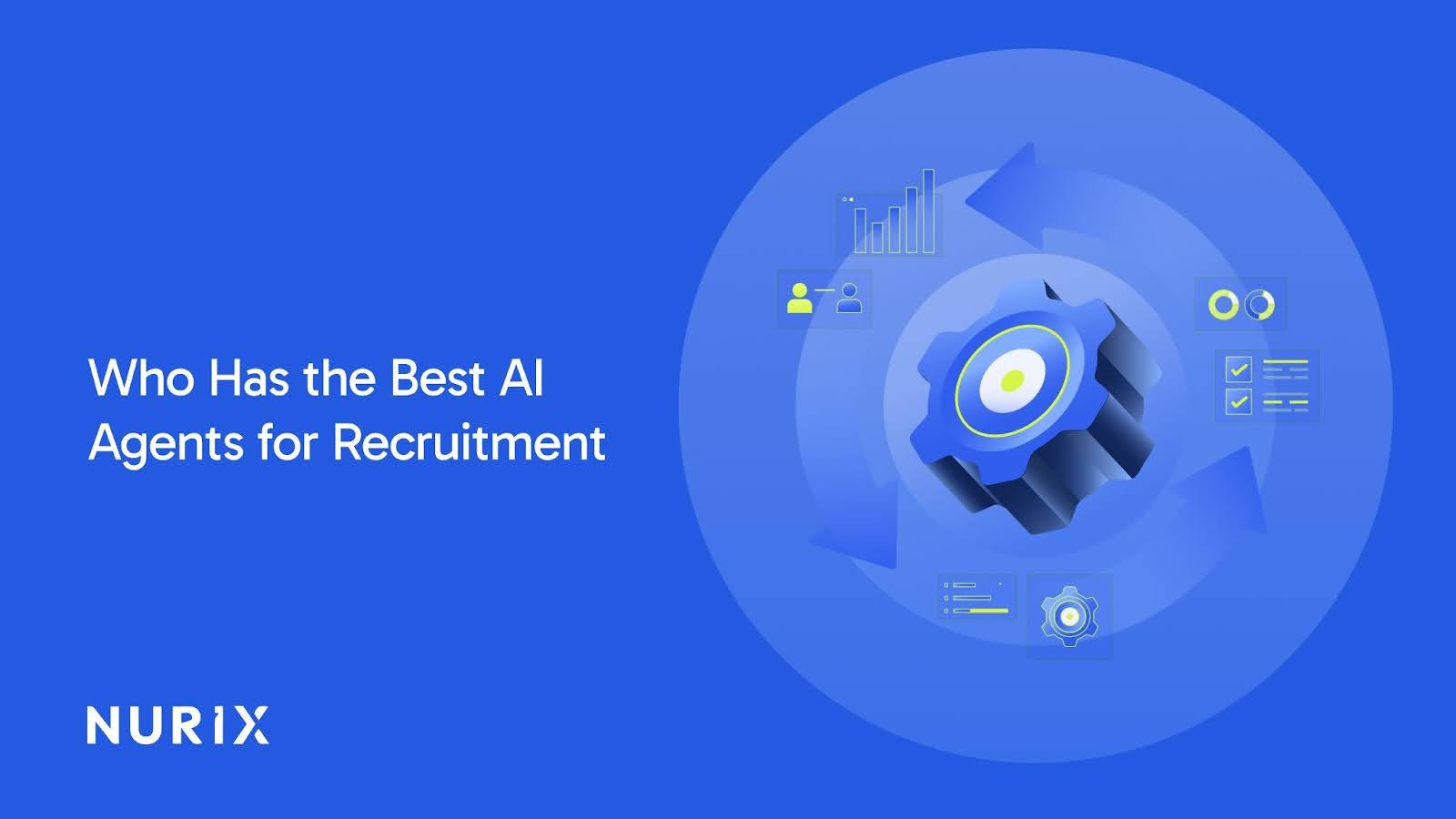Generative AI Use Cases and Challenges in Banking

Imagine a world where banking is efficient and personal. That's what generative AI is creating for banking. Generative AI is transforming the banking industry, and it's changing everything from customer service to fraud detection. But with great power comes great responsibility; This blog looks at the generative AI use cases for banking and the challenges.
Gen AI to Reshape Banking Business Models
Generative AI is not just a tool to augment existing processes; it's redefining the entire banking business model. By integrating AI into core banking functions, banks can offer personalized services, improve risk management, and streamline operations. This transformation makes banks more agile, responsive, and customer-centric, opening up new revenue streams and business opportunities. Among the most notable generative AI use cases for banking is the ability to deliver tailored financial services and products.
Key Areas of Impact

- Personalized Services:
- AI-driven insights allow banks to offer services tailored to individual customer needs.
- Enhanced customer satisfaction and loyalty through customized financial products and services.
- Risk Management:
- Predictive analytics help banks identify and mitigate risks better.
- Reduces financial losses and improves overall financial stability.
- Operational Efficiency:
- Automation of routine tasks frees up staff for more strategic work.
- Increases overall productivity and reduces operational costs.
- Customer-Centric Models:
- AI helps banks understand and anticipate customer needs.
- Creates more responsive and personalized banking experiences.
By focusing on these areas, generative AI is driving a comprehensive transformation in the banking sector, making it more dynamic and capable of meeting the evolving needs of customers and the market. The generative AI use cases for banking are revolutionizing the industry.
Now that we’ve explored the broader impacts, it's time to examine specific generative AI use cases that are revolutionizing the banking industry.
Generative AI Use Cases for Banking

Generative AI refers to AI that generates content, text, images, and more based on input data. In banking, this means a whole host of applications to improve efficiency, customer experience, and security.
Use Case 1: Better Customer Service with AI
One of the biggest generative AI use cases for banking is improving customer service. Traditional customer service doesn't always meet the needs of diverse customers on time. Generative AI can assist in creating virtual assistants that respond to customer queries efficiently. These AI-driven assistants can analyze customer data to give personalized recommendations and improve overall customer experience.
Example:
- Bank of America's virtual assistant, Erica, uses AI to provide personalized financial advice, assist with transactions, and offer budgeting tips. Since its launch, Erica has handled millions of customer requests, significantly enhancing customer satisfaction and engagement [Source]
Benefits:
- 24/7 Availability: Unlike human advisors, AI-driven assistants are available 24/7, so customers get support whenever they need it.
- Personalized Interaction: AI can interact based on individual customer data to improve satisfaction and loyalty.
Use Case 2: Stopping Fraud Before It Happens
Another generative AI use case for banking is its ability to detect anomalies, making it a powerful tool for fraud detection. By analyzing transaction patterns and customer behavior, AI can detect fraud that would be hard for humans to detect.
Example:
- HSBC employs AI to analyze transaction data for unusual patterns indicative of fraud. By integrating AI into their fraud detection systems, HSBC has significantly reduced the incidence of fraudulent transactions, protecting customers and saving millions of dollars annually. [Source]
Benefits:
- Real-Time Monitoring: Continuous monitoring ensures suspicious activity is detected and addressed immediately.
- Reduced False Positives: Advanced algorithms minimize false alarms so genuine transactions aren't flagged unnecessarily.
Use Case 3: Faster Document Processing
AI can process loan applications, verify documents, and assess creditworthiness in minutes. Faster approvals lead to happier customers.
Example:
- JP Morgan's COiN (Contract Intelligence) platform uses AI to review loan agreements and other documents. This system can process thousands of documents in seconds, significantly speeding up loan processing and reducing operational costs. [Source]
Benefits:
- Efficiency: Automation reduces document processing time so that staff can focus on more complex tasks.
- Accuracy: AI-driven processes are less prone to errors compared to manual handling, ensuring data integrity.
Use Case 4: Smarter Risk Management
Generative AI helps with risk management by predicting market trends and assessing risk more accurately through historical and current data analysis, which is one of the best generative AI use cases for banking.
Example: Wells Fargo uses AI to analyze vast amounts of data to predict and manage risks. This helps the bank proactively address potential issues, improving financial stability and decision-making. [Source]
Benefits:
- Informed Decision-Making: With accurate predictions, banks can make better decisions regarding investments and lending.
- Proactive Risk Mitigation: Identifying potential risks early allows banks to take preventative measures, reducing financial losses.
Use Case 5: Tailored Financial Products
Banks can use generative AI to create financial products that are bespoke to individual customers, from personalized mortgage plans to tailored investment portfolios.
Example:
- BBVA uses AI to offer personalized financial products and advice to its customers. By analyzing individual financial behavior, BBVA provides tailored recommendations and products, enhancing customer satisfaction and engagement. [Source]
Benefits:
- Personalization: Financial products are tailored to meet the unique needs of each customer, enhancing their overall experience.
- Customer Retention: Offering personalized solutions helps retain customers by meeting their specific needs more effectively.
Use Case 6: Deep Insights with Advanced Analytics
One of the generative AI use cases for banking is providing advanced analytics to give deep insights into customer behavior and market trends, allowing banks to predict customer needs and market shifts.
Example:
- Citibank uses AI to analyze customer data and gain deep insights into their behavior. This helps the bank develop targeted marketing strategies and personalized offers, increasing customer engagement and satisfaction. [Source]
Benefits:
- Better Customer Understanding: Deep insights into customer behavior help develop strategies to meet their needs better.
- Increased Revenue: Targeted marketing and personalization can increase customer engagement and sales.
Use Case 7: Enhanced Anti-Money Laundering (AML) Practices
Generative AI is proving to be a powerful tool to enhance Anti-Money Laundering (AML) practices. AI models can analyze vast amounts of transaction data, customer profiles, and historical patterns to identify suspicious activities.
Example:
- Standard Chartered uses AI to enhance its AML practices. The AI system analyzes transaction data to identify suspicious activities, improving detection and reducing false positives. [Source]
Benefits:
- Improved Detection: AI improves the detection of illicit activities and reduces false positives.
- Regulatory Compliance: Better AML practices ensure banks comply with regulations, avoid fines, and maintain trust.
Use Case 8: Enhancing Customer Loyalty and Retention
One of the most under-discussed generative AI use cases for banking is customer loyalty and retention. By delivering highly personalized experiences and proactive support, AI can increase customer satisfaction.
Example:
- Lloyds Bank uses AI to predict customer needs and provide proactive support. This has led to higher customer satisfaction and retention rates, as customers feel more valued and supported. [Source]
Benefits:
- Increased Customer Trust: Proactive support fosters trust as customers feel valued and cared for.
- Higher Retention Rates: Satisfied customers are more likely to stay with the bank, reducing churn rates.
Use Case 9: Streamlining Internal Operations
Generative AI is not just transforming customer-facing functions but also internal operations. From HR to IT support, AI can automate mundane tasks, allowing employees to focus on more strategic work.
Example:
- Deutsche Bank uses AI to streamline internal operations, including IT support and HR processes. This has led to significant improvements in efficiency and cost savings. [Source]
Benefits:
- Operational Efficiency: Automating mundane tasks reduces the workload on staff and speeds up internal processes.
- Cost Savings: Efficiency and reduced manual labor translate to significant cost savings for the bank.
Use Case 10: Personalizing Marketing Strategies
Generative AI can transform marketing strategies by personalizing content and offers for each customer, making marketing more effective and relevant to the target audience.
Example:
- Royal Bank of Canada uses AI to personalize marketing campaigns. By analyzing customer data, the bank can send targeted offers and promotions, leading to higher engagement and conversion rates. [Source]
Benefits:
- Higher Engagement Rates: Personalized marketing messages resonate more with customers, leading to higher engagement.
- Improved ROI: Targeted campaigns ensure marketing budgets are spent more efficiently, yielding a higher return on investment.
Use Case 11: Automating Compliance Processes
Compliance is a big part of banking, and generative AI can automate many compliance tasks, ensuring banks meet regulatory requirements without the need for manual oversight.
Example:
- UBS uses AI to automate compliance processes, including regulatory reporting. This ensures accuracy and timeliness, reducing the risk of non-compliance and associated penalties. [Source]
Benefits:
- Reduced Compliance Costs: Automation reduces the need for human resources dedicated to compliance tasks.
- Enhanced Accuracy: AI minimizes human error, ensuring all reports and processes meet regulatory requirements.
Implementing generative AI successfully requires a solid foundation. Let's explore the essential elements that banks need to focus on to maximize AI benefits.
Getting Started with Gen AI
Implementing Gen AI in banking starts with understanding your institution's specific needs and goals. Banks should start by identifying where AI can make the biggest impact, backed by high-quality, readily available data, whether it's customer service, fraud detection, or operational efficiency. Working with AI experts and technology partners will help with the integration process.
Key Foundations of Generative AI Implementation in Banking
Gen AI in banking requires a solid foundation, which means investing in the right technology, data quality, and an innovation culture. Continuous training and development for employees are also crucial to maximize the benefits of AI.
Key Foundations:

- Technology Infrastructure: Invest in scalable and robust AI platforms and tools. Ensure compatibility with existing banking systems and infrastructure.
- Data Quality: Implement data governance frameworks to maintain high data quality. Regularly clean and update data to ensure accuracy and relevance for AI models.
- Innovation Culture: Foster an organizational culture that embraces technological innovation. Encourage experimentation and adoption of new AI technologies.
- Employee Training and Development: Provide continuous training programs to upskill employees in AI and related technologies. Encourage a learning environment where employees can adapt to new AI tools and processes.
- Regulatory Compliance: Ensure AI implementations comply with financial regulations and data privacy laws. Regularly audit AI systems to maintain compliance and security standards.
- Cross-functional collaboration: Promote collaboration between IT, data science, and business units. Establish clear communication channels to integrate AI initiatives across departments.
By focusing on these foundational elements, banks can effectively implement generative AI, ensuring sustainable growth and a competitive edge in the industry.
Why Partner with Nurix for Gen AI in Banking?
Partnering with an experienced AI provider like Nurix can make all the difference. Nurix offers custom generative AI use cases for banking solutions tailored to the industry's needs. Innovation, security, and customer satisfaction are at the forefront of everything Nurix does to help banks navigate the complexity of AI and achieve their goals.
Features:
- Cutting-Edge Expertise: Nurix’s team is made up of experts from top tech companies and universities so our AI is cutting-edge.
- Seamless Customer Management: AI agents manage customer interactions across multiple channels, increasing engagement and happiness.
- 24/7 Real-Time Support: Nurix’s AI-powered support provides continuous, personalized support and a consistent brand voice.
- Continuous Improvement: The AI systems are designed to learn and adapt so they stay in line with your bank’s goals.
- Integration and Scalability: AI solutions are built to integrate with your existing infrastructure for reliability and security.
- Proven Trust and Support: Funded by top investors and trusted by many clients, Nurix delivers results with AI.
Conclusion
Generative AI use cases for banking are transforming the industry into a hub of innovation and efficiency. From personalized customer service to fraud detection, there are numerous promising applications. However, banks must navigate data privacy, ethical considerations, and technical integration to unlock the full potential of generative AI.
By embracing these opportunities and addressing the challenges that come with them, banks can improve their operations and offer more value to their customers. The future of banking is closely tied to the evolution of generative AI, promising a more dynamic, efficient, and customer-centric industry.
Ready to revolutionize your banking operations? Start your AI transformation today with Nurix. Contact us to build a reliable, scalable, and secure AI solution that turns interactions into opportunities for growth. Visit Nurix AI for more details and to get started.









